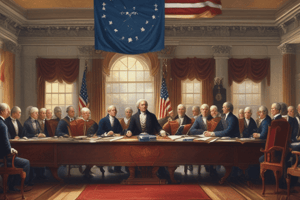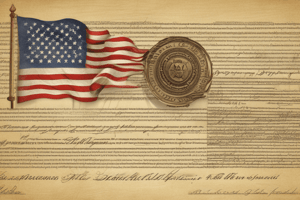Podcast
Questions and Answers
What was the Three-Fifths Compromise?
What was the Three-Fifths Compromise?
- A compromise between federalists and anti-federalists
- A compromise on state boundaries
- A compromise on the representation of slaves in population counts (correct)
- A compromise regarding taxation
What is the government structure defined by the division of powers among state and national authorities?
What is the government structure defined by the division of powers among state and national authorities?
Federal system
Who were the Federalists?
Who were the Federalists?
Those who favored the Constitution
Who were the Anti-Federalists?
Who were the Anti-Federalists?
What are the three branches of the new government?
What are the three branches of the new government?
What is the role of the Executive branch?
What is the role of the Executive branch?
What is the Legislative branch responsible for?
What is the Legislative branch responsible for?
What is the role of the Judicial branch?
What is the role of the Judicial branch?
What are the requirements to be a member of the House of Representatives?
What are the requirements to be a member of the House of Representatives?
What is the term length for a member of the Senate?
What is the term length for a member of the Senate?
What is a requirement to be President of the United States?
What is a requirement to be President of the United States?
How many justices are on the United States Supreme Court?
How many justices are on the United States Supreme Court?
Who nominates electors for the Electoral College?
Who nominates electors for the Electoral College?
What is the term for the houses of Congress?
What is the term for the houses of Congress?
The Constitution is divided into ___ articles.
The Constitution is divided into ___ articles.
What are the three major parts of the Constitution?
What are the three major parts of the Constitution?
How long is the term for a representative?
How long is the term for a representative?
What is the procedure for appointing a federal judge?
What is the procedure for appointing a federal judge?
What is judicial review?
What is judicial review?
Who can propose an amendment?
Who can propose an amendment?
Who must approve an amendment?
Who must approve an amendment?
Flashcards are hidden until you start studying
Study Notes
Compromises and Government Structure
- The three-fifths Compromise determined that each enslaved person would be counted as three-fifths of a person for representation and taxation purposes.
- Federal systems feature shared power between state and national authorities, promoting a balance in governance.
Federalists and Anti-Federalists
- Federalists supported the Constitution, advocating for a strong national government.
- Anti-Federalists opposed the Constitution, fearing central authority might undermine individual liberties.
Structure of the New Government
- The government is divided into three branches: Executive, Legislative, and Judicial.
Executive Branch
- Headed by the President, who must be at least 35 years old, a natural-born citizen, and a U.S. resident for 14 years.
- Presidential elections are held every four years, with a two-term limit established by the 22nd amendment.
Legislative Branch
- Comprised of Congress, which is divided into two houses: the House of Representatives and the Senate.
- House of Representatives members must be at least 25 years old, U.S. citizens for seven years, and reside in the state they represent; they serve two-year terms.
- Senators must be at least 30 years old, U.S. citizens for nine years, and reside in the state they represent; they serve six-year terms with one-third up for re-election every two years.
Judicial Branch
- Headed by the Supreme Court, whose membership and qualifications are loosely defined in the Constitution.
- Congress determines the number of justices, with the count fixed at nine since 1869; justices serve lifetime terms unless they retire.
- Judicial review allows the Supreme Court to assess the constitutional validity of legislative acts.
The Electoral Process
- Electors are nominated by state party committees and cannot hold federal office, be high-ranking officials, or have engaged in rebellion.
- Voters elect electors on election day, who then cast the official votes.
Constitutional Framework
- The Constitution consists of seven articles detailing the structure and function of government.
- Major parts include the Preamble, the seven articles, and the Bill of Rights.
Amendment Process
- Congress and the House of Representatives have the power to propose amendments.
- Amendments must be approved by a majority of states.
Major Government Responsibilities
- The President can veto laws passed by Congress, maintaining checks and balances.
- The Supreme Court interprets the Constitution to ensure laws comply with constitutional principles.
Studying That Suits You
Use AI to generate personalized quizzes and flashcards to suit your learning preferences.





